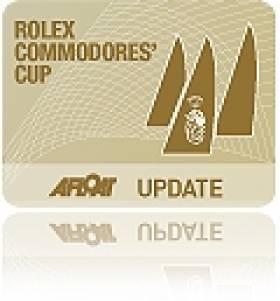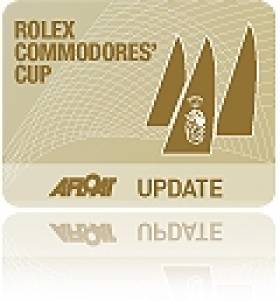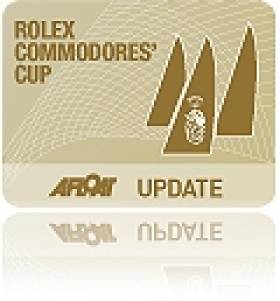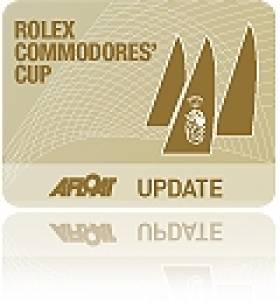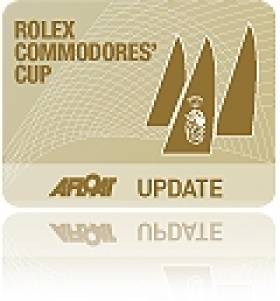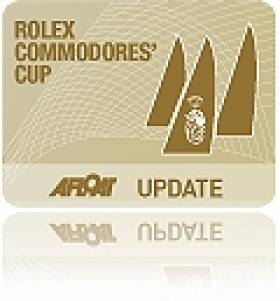Displaying items by tag: roxy 6
Commodores' Cup Celebration Dinner to be Held at Royal Cork
Team Ireland boats, Antix - Anthony O Leary, Marinerscove.ie - Dave Dwyer and Roxy 6 - Rob Davies and Andrew Creighton, will be represented on the night.
The dinner cost will be €30 and booking will be on first come/first served basis. Book with [email protected] or call 021 4831023.
The Commodore's Cup Team - Sailors of the Month for August
The 2010 Irish Commodore's Cup team are jointly the Afloat.ie/Irish Independent "Sailors of the Month" for August. In times past, we've had two or even three "Sailors of the Month" at once. And we even had a family – the Dicksons of Lough Ree – getting the honours together. But it's the first time that an entire team have been given the accolade.
However, the 2010 Irish Commodore's Cup team achieved their totally convincing win with a display of team spirit which was of truly international standard, and the judges acclaim the entire squad – and their enthusiastic and able management – with the accolade.
It was realized that selecting any individual sailor or one of the crews from the three boats was going to be difficult. Even when you tried to congratulate any of them, they would tend to heap praise on another of the boats. And on the rare occasion when things went wrong – as when Antix was caught by a rule break at the start of the final and clinching race – the skippers readily accepted blame.
In that instance, Antix boss and team captain Anthony O'Leary declared afterwards that he'd been "110% in the wrong". Admittedly it's not so painful saying that when you go on to sail an absolute blinder of a heavy weather race to finish second in class despite the setback of taking your penalty turn. But even so O'Leary, Dave Dwyer on marinerscove.ie, and the new boys on Roxy 6 were exemplary in their achievement.
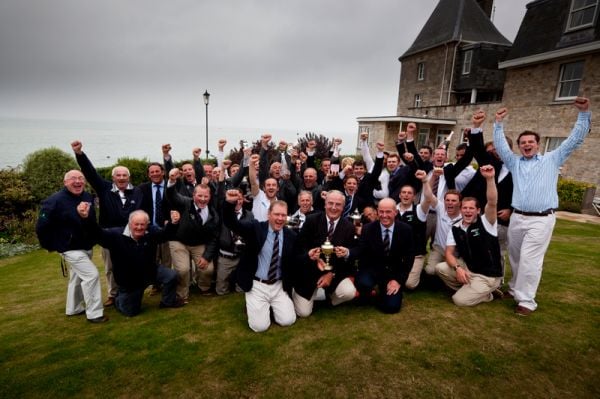
Ireland's Commodores Cup Team is August's Sailors of the Month. Photo: David Branigan
Roxy 6 was given special praise as she was still very raw, a new Corby 36 built for Rob Davis in Pembroke in Wales, and put together on the water at some speed by a Cork crew headed by Andrew Creighton, with Maurice "The Prof" O'Connell invaluable as the single permitted onboard professional.
And they sailed with the steady consistency and that sense of the bigger picture which is the key to team success. Ashore, Barry Rose of the Irish Cruiser Racing Association was always available as manager, and the result was the kind of result the Irish sailing community have dreamed about for decades. Not only have we been within a whisker of winning the Commodore's Cup in recent years, but way back in the great days of the Admirals Cup in 1979, the Irish team went into the final event of the series, the Fastnet Race, with what seemed a commanding points lead.
The notorious Fastnet storm of 1979 put paid to that. It was ironic that it was extreme Irish weather which blasted our chances. But the pain of that, and other blighted hopes, were so gloriously blown away in the Solent on Saturday August 22st as the final race was completed with Ireland's winning points piled high.
Ireland's Commodore's Cup team Crew List HERE.
Commdore's Cup Coverage HERE
Unstoppable Ireland Win 2010 Commodores' Cup
Ireland has won the 2010 Commodores' Cup but it was not without final race drama this morning. According to reports from the race course, Team Captain Anthony O'Leary was in a collision before the start of the race with a French competitor when winds gusted to 30 knots.
The news that Ireland has won the Cup is already being celebrated in Crosshaven this lunch time, the home of the three boat team.
The winning Ireland team from Royal Cork was Antix, Anthony O'Leary (Ker 39); Marinerscove.ie David Dwyer (Mills 39) and Roxy 6 Robert Davies (Corby 36).
After a series of near misses in the Commodore’s Cup, there are many reasons why 2010 was entirely appropriate timing for the Irish win in Cowes this week.
Ireland fielded a single three boat team instead of its previous two and three team approach. Individual performances this season though, including a win at the British IRC Nationals were early indicators that Ireland still had the will to win the Commodore's Cup.
And it was obvious this week from the first inshore race on Sunday that Ireland would take a lot of stopping.
To send your congratulations to the Irish team click here
To join our forum thread click here
Ireland Lodges Appeal at Commodores' Cup
Ireland has lodged an appeal this morning against a jury decision last night that reduced Ireland's overall lead in the Commodores' Cup by ten points. The decision concerns the result of a Hong Kong boat, Christopher Opielok's Corby 36 Rockall III that was granted redress after a protest over the location of a mark. The redress affects the points of Ireland's small boat Roxy 6 who won yesterday's race. It's just one small example how the Commodores' Cup can turn says Ireland's Barry Rose in the podcast below.
The jury decision is downloadable below.
Forum debate on the Commodores' Cup HERE
Ireland Continue to Lead Commodores' Cup
Two race wins and a third place for the Irish Cruiser Racing Association (ICRA) team at Cowes have extended Ireland's lead by ten points overnight as the event reaches its penultimate phase tomorrow with the Round Isle of Wight Race. Strong winds gusting to 25 konts are forecast and the team is focussed on avoiding damage.
Ireland has a 40.5 point lead over second placed Hong Kong and 49 points over third-placed France Blue.
Team Captain Anthony O'Leary on Antix won Class 1, continuing his consistent form of race wins and second places this week. Roxy 6 skippered by Andrew Creighton benefitted from an apparent navigational error by Hong Kong's Rockall III that was leading comfortably in Class 3 until a course change was missed and the Irish team boat won the race. Dave Dwyer's marinerscove.ie placed third in Class 2 in a race dominated by British boats La Reponse and Quokka 8.
"We have a very workman like approach to prepararing thoroughly for the 50-miler tomorrow," commented Barry Rose, Commodore of ICRA. "The course has lots of complicated corners and we expect it to be breezy. Its a big challenge that we're taking day by day; our plan goes on as it has from the beginning, concentrating on every detail to be as prepared as we can."
The race around the island counts for 1.5x bonus factor and will be especially tough in the forecast conditions. "The race around the Isle of Wight is going to be pretty long and pretty tough for the small boats," Maurice O'Connell, mainsheet trimmer on Roxy 6. "We're just going to keep doing what we're doing and hope that it all comes good."
A grim overcast start and lumpy wind against tide conditions gave way to brilliant sunshine and a summery finish off the Royal Yacht Squadron for the Rolex Trophy Day inshore race at the 2010 Rolex Commodores' Cup. Today's one race was held around multiple marks in the central western Solent starting in 18 knot southwesterlies with a wet beat through short chop before the tide turned and the wind dropped gradually through the race, ending at below 10 knots .
It was another solid day for the Irish team, leaders since the opening day of the regatta last Sunday. Their big boat, Anthony O'Leary's Ker 39 Antix and their small boat, Robert Davies' Corby 36 Roxy 6 both won their classes today while David Dwyer's marinerscove.ie posted a third. No other team was close to being as consistent today.
In the small boat class Roxy 6 came out on top partly thanks to a navigation error on the Hong Kong boat, Christopher Opielok's Corby 36 Rockall III [at the time of going to press this was subject to a protest for redress]. "We were very lucky," said Roxy 6's helmsman Andrew Creighton. "Rockall went to a wrong mark and they were ahead of us. With them making that mistake it obviously pushed us into first, although one of the French guys, Goa, came very close to us, but we had them by about 25 seconds."
Roxy 6 was only launched in April, but has had an intensive season at regattas throughout the UK and her native Ireland. Designed by Cowes resident John Corby, the 36 footer relished today's conditions. "The short Solent slap suits this sort of boat," said Creighton.
Back at Cowes Yacht Haven, Commodore of the Royal Ocean Racing Club, Andrew McIrvine stepped off the boat he co-owns with Peter Morton in buoyant mood. His Beneteau First 40.7 La Réponse won the mid-sized class today by two and a half minutes on corrected time ahead of past RORC Commodore Peter Rutter's Quokka 8.
"We just went fast," said McIrvine explaining today's result. "Upwind we go higher and faster than we ought to for this size of boat if you consider it is a cruiser racer. Downwind we go quick too. It is a semi-standard production boat and it does go extremely well." McIrvine acquired the boat this year from past Rolex Commodores' Cup winner Géry Trentesaux and has changed the bulb keel back to a fin but kept the go-faster carbon fibre mast.
"Tactically we didn't make any mistakes. The crew are fantastic. All the gybe sets worked perfectly. There were no foul-ups on any of the manoeuvres. They are a very well tuned team now," added McIrvine.
Second behind Antix, Bernard Gouy's Inis Mor in France Yellow had their best day yet, making it a Ker 39 1-2 in the big boat class today.
"Our spinnaker legs were better today with the asymmetric [spinnaker]," stated Laurent Gouy, the owner's son. "We have some difficulty when it is really downwind and when it is wavy we can compensate to slide downwind a bit better."
Behind them in third, the Hong Kong big boat EFG Bank Mandrake posted their best result of the regatta today. "I thought it was superb," said Nicholas Burns, co-owner with Fred Kinmonth. "I think we sailed as good a race as we could have done. We tacked about 20 times on top of Antix and she still beat us! She is going very fast at the moment, so I think our tactics will change now. We'll just go for the best position we can and not try and knock the Irish back."
As to the regatta generally, Burns said: "Very challenging, superb sailing, all the competition is extremely good and we're really enjoying it. It is colder than we are used to. We are used to Asian temperatures of 29-33 degrees Celsius. We have lots of warm ski gear on, but it has been really good fun."
EFG Bank Mandrake, a Mills 40 design, previously raced at the Rolex Commodores' Cup in 2006 as an Irish entry under the name Tiamat. She was shipped to the UK from Palma especially for this regatta and will head to Hong Kong afterwards. "It is great fun," says Burns of the regatta. "It is nice to have a team race with three boats in different classes. It is a really good idea. You feel you are sailing some of the best sailors in the world which is challenging."
At the end of play today the Hong Kong team lies second to the runaway Irish, but have been knocked back due to their small boat Rockall III's mishap, causing her to finish ninth (depending upon the outcome of their protest). From being 30 points astern of the Irish yesterday, the Hong Kong team is currently 40.5 points behind them. However the regatta is far from over with a race around the Isle of Wight coming with a x1.5 points co-efficient tomorrow (Friday) and a double points scoring inshore race to conclude the regatta on Saturday.
As RORC Commodore Andrew McIrvine puts it, "although the Irish have got away there is still almost half the points to play for. The weighting keeps the whole thing open right to the end of the event. At a lot of regattas by this stage it is signed sealed and delivered. We have still got a long way to go."
Conditions for the race around the Isle of Wight look set to be brisk with southwesterly winds gusting up to 25 knots forecast.
Crews competing at the Rolex Commodores' Cup will return to offshore mode tomorrow. The Irish will look to consolidate their dominance, whilst those chasing, particularly Hong Kong, will look to take advantage of any errors by the all but impeccably sailed leaders.
Top Five Teams - Provisional Positions after completion of 6 races
Team / Points / Place
Ireland / 47 / 1
Hong Kong / 87.5 / 2
France Blue / 96/ 3
GBR Red / 103 / 4
France Yellow /110 / 5
Ireland Tackle Offshore Race to Take Commanding Lead
Boats were returning to Cowes Yacht Haven throughout yesterday, back from the offshore race of the 2010 Rolex Commodores' Cup. With a 2.5x point co-efficient this race had the potential to provide a major upset in the results, but after four days of competition the Irish team hold an even more commanding lead, now up to 29.5 points. Hong Kong has regained second place, this time with a 25-point cushion over the leading French team, which in turn is just 5 points ahead of GBR Red and 15 points ahead of France Yellow in fifth.
Dave Dwyer’s marinerscove.ie was overall winner of Class 2 while team captain Anthony O’Leary’s Antix scored second place. Rob Davies Roxy 6 skippered by Andrew Creighton was fourth in Class 3.
“We’re feeling quite positive as we’ve just had one of the best offshore results ever – the lads all worked their socks off,” commented Barry Rose, Commodore of ICRA. “We’ve strengthened our lead so we’re in a good, solid position and looking forward to the rest of the regatta.”
The team had all returned to Cowes by mid-afternoon to prepare the three boats for tomorrow’s (Thursday) Rolex Trophy race on a long-inshore race that is expected to last three hours. Friday will also feature a single race as the fleet competes for bonus points in the Round Isle of Wight course.
Saturday’s single race finale counts for double-points and strong challenges from Hong Kong, France Blue and Britain’s GBR Red are expected.
“Its still all to play for. Hong Kong are looking very strong and there are a lot of points still to be earned,” cautioned Rose. “There’ll be no change in our strategy – we have a plan and we’re going to stick to it. Its about grind out the results day by day.”
Hong Kong and Ireland scored equal points in the offshore race with the former's Rockall III winning the small boat class while the latter's marinerscove.ie claimed the mid-sized class.
On the water Rockall III was first home in the whole fleet, crossing the line just to the west of the entrance to Portsmouth Harbour at 10:40:41 BST, winning her class by almost one hour on corrected time. While racing for Hong Kong, where he used to live, Rockall III's owner Christopher Opielok is German. His crew is largely from Hong Kong but also includes two Dutch, one Irishman and three Australians. According to Opielok he bought his Corby 36 specifically to compete in the Rolex Commodores' Cup, "we have been preparing for this for a long time. The boat clocked since delivery to us last year, 4,000 miles. We did a lot of offshore racing. We have four very good helmsmen. The navigation was very well prepared. We had a good tactician and I believe altogether with a very good boat, ended up with this result."
Opielok said they faced stiff competition from the Irish team's small boat, Roxy 6, "we focussed on sail trim and sailed extremely hard without any rest. We knew we could only beat Roxy upwind. We put all our effort into the 60-mile beat and then we tried to control them downwind. Luckily the tide went with us and pushed us even further than expected." The tide was particularly beneficial on the final run into the finish.
Simon Henning, owner of the Alice II from GBR White was delighted to have won the big boat division. His Farr 45, the biggest yacht in this year's Rolex Commodores' Cup does not have a favourable rating and they have not performed well in the inshore racing so far. Having to continue past Anvil Point and on to the East Shambles mark in Weymouth Bay, the Class 1 course at 191-nautical-miles was some 35 nm longer than the Class 3 version, which simply did an about-turn at Poole. Yet Alice II reached the finish line just under four minutes astern of Rockall III.
Alice led the 30-boat fleet out of the Solent in the strongest conditions of the race and enjoyed a fantastic blast down to the Owers, the easternmost mark of the course, to the southeast of Selsey Bill. "We saw 24-25 knots [of wind] and we were surfing up to 17 several times – it was lovely," commented Henning. Thanks to this they caught the tide turning at the Owers and from there never looked back. Despite the wind dropping to five knots this morning, they claimed the big boat class by a margin of 1 hour 20 minutes on corrected time.
Aside from torrential rain yesterday afternoon, conditions were not as bad as had been forecast. In the southwesterly breeze the sea was being kicked up by the wind-against-tide on the first beat out of The Solent and apart from the overfalls off St Catherine's Point, the southern tip of the Isle of Wight, it was generally considered a pleasant race.
"It was great fun - the course had a fabulous variety," commented Anthony O'Leary, who's Ker 39 Antix corrected out to be second amongst the big boats. "Every corner we went around it seemed that the tide was against us, but that was part of plan to give us a varied course with all the options and all the challenges - and there were plenty. Going into Poole Bar in the middle of the night and the Anvil in the dark is a challenge but thankfully we got away and managed to hold the thing together."
O'Leary was thankful that the Irish team had cumulatively posted a solid result in this high scoring race. "You could easily lose the regatta if you had a disaster and in that respect it is certainly satisfying. But there is still plenty to do and there are still plenty of points available. We'll keep on chipping away."
David Dwyer's marinerscove.ie maintained the impeccable Irish performance, first home in the mid-sized class, although by the slender margin of three and a half minutes over Anthony Day's Blondie IV. Tactician on the Irish boat, Andy Beadsworth, commented that, "it was a really good race and it was nice to finish relatively early today." The team enjoyed spending most of the night racing in company with the big boats. "It wasn't that lumpy. We hardly had any water over the deck!" said Beadsworth, adding that he had tried to get some sleep only to be awoken when he overheard the rest of the crew about to make decisions on deck.
Finishing behind Rockall III in the small boat class was Bernard Moureau's JND 35 Gaia in France White. Tactician Alex Mercier said that they are improving with every race aboard their new boat. "The start was a bit improvised but we were able to place ourselves well and to maintain a good position during the entire night and this morning as well." They are still discovering Gaia but have found it goes well under spinnaker.
Behind them in third was Jim Macgregor's Elan 410 Premier Flair, which posted the best result for GBR Red, with another crew who had thought they would perform better inshore than off. The line-up includes British Olympic-squad 470 sailor Ben Saxton as tactician. "It was long but enjoyable, different. It was nice weather because it was windy enough and we made good progress and we finished close to other boats so that kept it fun the whole way around," said Saxton who admits he only slept for about five minutes. Saxton reckons they made their biggest tactical gains with the tide on the beat up to Poole.
Tomorrow the Rolex Commodores' Cup returns to racing on The Solent with one inshore course scheduled for Rolex Trophy Day. Crews get a well-earned rest following their efforts of the past 24 hours or so, with the start scheduled for noon BST. With two high scoring races to follow on Friday (the x1.5 Round the Isle of Wight Race) and Saturday (a double-points inshore race) the teams at the top know this event is far from over. The Irish will sleep more comfortably tonight having cruised through the major test of the week, but undoubtedly will be on alert tomorrow to avoid the pitfalls encountered by previous compatriot teams.
Top Five Teams - Provisional Positions after completion of 5 races
Team / Points / Place
Ireland / 42 / 1
Hong Kong / 71.5 / 2
France Blue / 84 / 3
GBR Red / 89 / 4
France Yellow /99 / 5
Ireland Hold Overall Lead But 'Dark, Wet Night' Ahead
The 17.00 BST sched showed Anthony O'Leary's Antix second among the big boats, David Dwyer's marinerscove.ie second in the mid-sized fleet and Robert Davies' Roxy 6 second among the small boats. With these results the Irish team would be on 44.5 points ahead of France Blue and Hong Kong tied in second on 71.5. GBR Red holds fourth on 86.5, followed by France Yellow in fifth.
As conditions improved following a damp and misty start to the 180-mile offshore race in the Rolex Commodores’ Cup, the three boats representing the Irish Cruiser Racing Association are maintaining good position at the front of their respective classes as the fleet settles in for a long night of beating westwards.
Other boats have already retired from the race after the breezy start off the Royal Yacht Squadron in West Cowes at 10.30am local time today. A brisk passage eastwards with a favourable tide saw the lead change as the fleet remained bunched. After passing the forts off Portsmouth and into open water close to Bembridge Ledge, the bigger boats started to pull away.
The 28-boats are racing in wind against tide conditions on the course westwards to Poole Fairway buoy before the smaller boats retrace their route back to Cowes for an expected finish during Wednesday. The larger boats have their courses extended further westwards from Poole towards Swanage.

“They’re setting down solidly after a hectic start,” said Barry Rose, ICRA Commodore. “Antix came out of it quite well on the northern end of the line while marinerscove.ie and Roxy were in a lot of traffic at the busy leeward end of the line. They’re now in quite promising positions.”
At the team briefing this morning, skippers and navigators heard that a lot will happen overnight which will be decisive as a front is expected come through which could lead to a change in wind and conditions; this could prove critical.
On estimated results this evening, Ireland continues to hold the overall lead of the event with strong challenges emerging from both France Blue and Hong Kong.
The 30 strong Rolex Commodores' Cup fleet shot off east down the Solent this morning with the wind and tide but under a grey rain-filled sky at the start of their high points scoring offshore race. The course for the 10 teams is full of zigzags taking them first out towards Selsey Bill while tonight they will be heading west along the bottom of the Isle of Wight en route for a mark off Poole Harbour. At this point the three classes will race slightly different courses before the run back east tomorrow morning that should see them finishing off a line to the west of Portsmouth Harbour sometime tomorrow afternoon.
At 17.00 BST Simon Henning's Alice II, a Farr 45, and the longest, highest rated yacht in the race, was approaching the Owers turning mark, the easternmost on the course, while the chasing pack were spread five to thirty-nautical miles astern of her. It seems likely that Alice II will steal a march on her Class 1 rivals, as her rounding of the Owers should coincide with the tide turning westbound, while those behind will face a further hour or two punching into it. Already Alice II in the GBR White team looks to be leading the big boat class on corrected time.
The absent Géry Trentesaux, the Frenchman who was instrumental in his country winning the Rolex Commodores' Cup in 2006 and 2002, would be proud. The First 40, Coup de Coeur, he co-owns with UNCL Commodore Marc de Saint Denis was leading Class 2 on handicap at 17.00 BST as part of the France Blue team. Meanwhile, in Class 3, it was the turn of the Hong Kong team to head the standings, with Christopher Opielok's Corby 36, Rockall III.
In the small boat class, Marc Alperovitch's A-35 Prime Time in France Yellow was holding fifth. Alperovitch said he had been pleased with their progress. Heading down the eastern Solent they had seen 20 knots but late in the afternoon the wind had dropped to 14 knots – less than forecast. "It has dropped earlier than planned," he reported. "Normally when the wind drops we should have a clear sky, but that is not the case at all. But maybe there is less pressure."
Just ahead of them, the crew on board Jim Macgregor's Elan 410 Premier Flair, lying seventh on handicap, were contemplating the night ahead and the lumpy conditions this evening heading west with the wind against the tide. "It was quite unpleasant earlier: wet and windy and horrible – good British summertime stuff," commented crew woman Jody Slater adding that on board they were seeing 16 knots from the southwest. "It is quite pleasant now. The wave action is a little uncomfortable, but apart from that is all right. It has stopped raining, which I am deeply happy about. Tonight hopefully won't be too unpleasant. It is supposed to be wind against tide. Unfortunately as one of the people taking seasickness pills, I don't look forward to the beating."
Owner Jim Macgregor had not managed to achieve his plan to use his boat's longer waterline length to shake off the smaller Corby designs. Macgregor, who pilots ships in and out of Poole harbour for a living and is father of the World Match Racing No.1 Lucy, said prior to the start that his crew, including Olympic 470 sailor Ben Saxton, comprised mostly inshore sailors. "Hopefully we'll stay awake tonight!"
This morning Simon Shaw, skipper on Michael Williamson's Summit 40 White Heat, the big boat in GBR Red, walked the course. "At around 5-6pm we get as far east as we are going to go and then it will be a long 12 hour beat all the way to Weymouth for us, around the back of the island. The tide is with us initially and then we are against on the mainland shore just under the Needles, so there will be a lot of tidal strategy in those areas and around Poole.
"It is going to be a really dark night. It is going to be wet – for us that beat is going to be the focus of the race really and the ability of crews to keep their boats trucking through the evening period. Our boat is a little tweaky so it will be doubly hard for us to keep it on the numbers in that environment." Shaw reckoned that they might rotate the helm and the main sheet trimmer to ensure they remained alert. They are expecting the wind to veer from the southwest back into the northwest tonight before settling back into the southwest tomorrow.
This evening as the teams prepare for a sleepless night on the rail, the British crews will be picturing the French teams sitting down below for a lavish dinner. In fact, the British might be getting the better deal. On White Heat they have a casserole to heat up for dinner, which will be eaten from dog bowls. On Prime Time Marc Alperovitch says they will be eating less palatable freeze-dried. "I love it – it reminds me of the Rolex Fastnet!"
Two yachts have retired to date: Cracklin Rosie (Class 1) and Artemis (Class 2) both from GBR Black.
The 2010 Rolex Commodores' Cup Long Offshore Race continues tomorrow, Wednesday, with the yachts expected to finish by the early afternoon. The forecast wind overnight is for 12 – 15 knots from the west and southwest. Tracking and provisional rankings available at: http://commodorescup.rorc.org/fleet-tracking/2010-live-offshore-tracking.html
Top Five Teams - Provisional Positions after completion of 4 races (Long Offshore not included)
Team / Points / Place
Ireland / 24.5 / 1
GBR Red / 49 / 2
France Blue / 51.5 / 3
Hong Kong / 54 / 4
France Yellow /59 / 5
The class positions that are updated every 15 minutes can be viewed online as follows:
Tracker: http://rorc.geovoile.org/commodorescup/
Class 1: http://admin.octracker.net/data/standings.aspx?id2=193
Class 2: http://admin.octracker.net/data/standings.aspx?id2=195
Class 3: http://admin.octracker.net/data/standings.aspx?id2=196
Ireland Leads By 20.5 Points after Day Two of the Commodores' Cup
After two more windward leeward races in bright sunshine and 15-18 knot winds Ireland's Antix scored a joint first and a second in the Rolex Commodores' Cup today. Marinerscove scored a fourth and a second. Roxy was seventh and first. After four races now sailed on the Solent, Ireland leads by 20.5 points from UK Red. France Blue is third on 51.50 points. More reports and photos later.
Commodores' Cup: Ireland is 'Team to Watch'
The pre-event press release says 'no clear cut favourite but Irish eyes are smiling'. It's the kind of pressure Ireland's three boat team can do without after so many near misses in this event. But as they go afloat this morning for the first race there is no dismissing the fact that Ireland's single boat is seen as a major threat, especially if as forecasted, the winds on the Solent are moderate to strong. (You can send team Ireland good wishes HERE.)
International entries from as far afield as Hong Kong and South Africa have descended on Cowes ready for the start of the biennial Rolex Commodores' Cup.
As usual the event is for teams comprising three boats in different IRC rating bands, the boats ranging from 35-45ft in size. Teams are national with at least 50% of the crew coming from the country they are representing. The Rolex Commodores' Cup is also strongly Corinthian: only two professional sailors are allowed on the Class 1 boats and just one aboard Class 2 and 3 entries.
This year, the tenth edition of the competition, 10 teams are competing, the largest contingent coming from France, who are fielding four teams; GBR has three teams and Hong Kong, Ireland and, for the first time, South Africa each with one. Whilst the team numbers are down from two years ago, "the top four or five teams are as good as they were last time," says Eddie Warden Owen, CEO of the event's organisers, the Royal Ocean Racing Club.
In terms of the form, Warden Owen thinks the Irish will be ones to watch, as they have certainly been in the past, although they have never won; "they are very competitive, they seem highly focused and they have some very good amateur sailors on board as well as professionals." The Irish team is led by experienced Rolex Commodores' Cup skipper Anthony O'Leary and his Ker 39 Antix.

Dockside in Cowes for the Rolex Commodores' Cup. Photo: Kurt Arrigo
South Africa and Hong Kong also have strong entries, the latter having learned from competing here two years ago, again with the driving force of Jamie McWilliam behind them.
Warden Owen reckons that the dark horses at this event are the British and French teams. "The unknowns for me are the French teams because there are some good individual boats, but how they play out overall, I don't know."
Defending champions from 2008 are GBR Red, where the only return entry is former RORC Commodore Peter Rutter, this year skippering Quokka 8, the mid-sized yacht. Rutter's new vessel is a Grand Soleil 43, a sistership to the most successful yacht at the 2008 event.
Rutter was instrumental in picking his GBR Red team mates in Michael Williamson's Summit 40 White Heat, as the Class 1 boat and Jim Macgregor's Elan 410 Premier Flair in Class 3. "We are very much a tight team – we learned that from GBR Red last time. It is going to be an interesting regatta because it looks like there are going to be some very light days and some very heavy days."
The equivalent to GBR Red among the large French entry is France Yellow, which includes repeat entrants to this event, Philippe Delaporte and his J/122 Pen Azen and Marc Alperovitch and Jerome Huillard's A-35 Prime Time. They are joined by Bernard Gouy's Inis Mor - a British designed Ker 39 with an Irish name, points out skipper and owner's son, Laurent Gouy. While this is Inis Mor's first Rolex Commodores' Cup, the Gouys have for the last years been alternating Cowes Week and the Rolex Fastnet Race with Cork Week and the Round Ireland – this year moving on to this event.
Like GBR Red, France Yellow also organised themselves as a team and presented themselves to the RORC's French equivalent, the Union Course Au Large (UNCL), before Christmas. Inis Mor is one of the most successful IRC boats on the French circuit and usually podiums at the event in which she competes. As to how he thinks they will get on this week Laurent Gouy will not be drawn: "I would not dare to say! It is very complex."
The other French team that stands out is France Blue featuring Nicolas Loday and Jean Claude Nicoleau's familiar Codiam, a Grand Soleil 43, but also Marc de Saint Denis and Géry Trentesaux's First 40 Coup de Coeur, although we understand the wily Trentesaux, a Rolex Commodores' Cup veteran and winner in 2006 will not be in Cowes until Friday. The weak link in France Blue could be Samuel Prietz' X-40 Goa, but only because the boat is still new, having been launched in May.
Making one of the greatest efforts to compete in this year's event is Philipp Gutsche and his Mark Mills-designed Landmark 43, Windpower, which was shipped up from the southern hemisphere to be the South African team big boat.
"It's on my bucket list! Why not at my age?!" says Gutsche of why he is here. "We have done very well this year in South Africa in IRC and we won the South African Championship, in May. We have a good crew and a good boat - why not test our mettle against everyone else for the fun of it?"
"As a team I hope we will do very well. We'll be starting off as the weakest of the three boats. Cowes and the Solent are not easy, especially for foreigners." Gutsche had never sailed here before he competed at this year's Cowes Week. "It has been great fun. We are looking forward to it."
The racing format over the next week remains the same as it was in 2008, with a mixture of inshore races in the Solent plus a 24-36 hour long offshore race starting on Tuesday and a race around the Isle of Wight on Friday. The event culminates in a double points scoring inshore race on Saturday.
Conditions this week are expected to be particularly difficult, with light winds on some days, combined with some of the most powerful tides of the year. For example, today (Saturday) the famous Brambles Bank cricket match took place; the one-day each year the tide is so low as to expose the sand bank in the middle of the Solent. As Simon Shaw, skipper of the GBR Red big boat White Heat points out "I have never seen so much tide – we've seen 4 knots!" Conditions for the first few days of the regatta look set to have the wind from north, typically an awkward wind direction in the Solent, and around 7-14 knots. "There is discrepancy about how windy. Some people think on Tuesday there is going to be a load more breeze. I'm not so sure. Expect it to be from the north, fickle and swingy," predicts Shaw.
Whatever the conditions, the spirit and camaraderie exhibited on shore over the past couple of days of measurement and registration bodes well for a hard, but fair fought week of competition.
e months to go to the 10th edition of the biennial Rolex Commodores' Cup, the international fleet has every prospect of being one of the more exotic in recent events. A noteworthy success in these straightened times. The headline foreign contingent is perhaps South Africa, participating at the regatta for the first time. Hong Kong has confirmed it will be back following its happy venture in 2008. Thereafter, the northern European teams – Ireland, France and the United Kingdom - that are the traditional backbone of the event - will be present in numbers. Organisers, the Royal Ocean Racing Club, anticipate a total of 12 teams. Racing is from 15 to 21 August, with close of entry on 12 July.
The Rolex Commodores' Cup is a weeklong series mixing inshore racing on the waters in and around The Solent, the body of water separating the Isle of Wight from the mainland United Kingdom, with an offshore course that takes the fleet out into The English Channel and a course round the Isle of Wight. All of the racing is typified by one thing. Comprehensive knowledge of the tides and currents affecting these areas is essential. Furthermore, it has been proved time and again that is not just the team with the best boats or the best sailors that wins. It the team that is the best prepared in all aspects.
Take the Hong Kong team, led by Jamie McWilliam. Having finished fifth overall in 2008, surprising many of the more seasoned campaigners in the process, McWilliam and his teammates were resolute in their determination to return. Not just to participate, mind you, but to have a crack at winning. "In 2008 we arrived with a crew that had trained hard but which had never seen the boats before the regatta, as they were either charters or brand new. This meant that we spent quite a bit of important time just before the event working on the boats instead of working on our speed, and as a result we were still learning about the boats during the series. Our team this time was determined to avoid that mistake," comments McWilliam, explaining that this time, "all the boats are owned by Hong Kong owners and we therefore have much more time [to prepare]. Our full team will be at the UK IRC Nationals in late June and we are scheduling other weekends over the summer for the boats to have new sail trials."
It is a tall order to travel almost halfway around the world to participate in a three-boat team event. The three yachts needed to compete range in size, roughly, between 35 and 45 feet. There are crews to be identified, accommodation and travel to be arranged. McWilliam is clear that it is worth the effort, "it's always exciting going to an event where you think you have a chance to win but where you know you're going to have to really perform to achieve that. It provides a great combination of expectation, anticipation, and nerves. Combined with the knowledge that we are representing the small sailing community in Hong Kong, it's a really exciting deal."
The Hong Kong team is made up of Rockall III, a Corby 36 owned by Chris Opielok, in the small boat slot. 'Opie', as he is known, is a Hong Kong sailing legend, having won two Admiral's Cups for his native Germany. Rockall III is the former Rosie, which has a dominant history in UK & Irish IRC racing. The middle boat is Blondie IV, a Mills (King) 40 chartered by Anthony Day from Helmuth Hennig, both very well known Hong Kong racers. Blondie was 2nd in class in Rolex Commodores' Cup 2008 and has an exceptional track record under her former owner. The big boat is Mandrake, Nick Burns' Mills 40.5, formerly Ngoni and Tiamat. As Tiamat, she had an outstanding Rolex Commodores' Cup in 2006.
McWilliam acknowledges the difficulties involved for foreign teams, particularly getting the right boats in the right condition to the venue when they are located more than a delivery trip away. He clearly believes more countries should look more seriously at the possibilities, "I would definitely encourage other teams to participate. The Solent puts unique and intense pressure on crews and seemingly trivial moments turn out to be really critical, like a down tide bottom mark rounding where you've got to be perfect in order to hold your lane to get out of the current. I also believe that the best team here has always won the event, and that's the best recommendation I know for a regatta."
The Hong Kong team is looking forward to renewing rivalries with some of the teams it competed against in 2008. They are not here to make up the numbers, "we really enjoyed the event in 2008 and feel that the event is a good match for the type of sailing we do in Hong Kong, and therefore represents a great opportunity for Hong Kong to compete against peers and find out where we rank. We were happy with our 5th position in 2008 but saw it very much as an initial effort and unfinished business."
The Rolex Commodores' Cup will be held off Cowes, Isle of Wight, from 15 to 21 August. Entries, which must be made by Member National Authorities, close on Monday 12 July.
Irish crew list HERE
Entry List HERE
You can send team Ireland good wishes HERE
Commodores Cup: Send YOUR Good Luck Wishes HERE!
MANY OF YOU SENT GOOD LUCK WISHES AND NOW YOU CAN SAY WELL DONE TOO! SCROLL DOWN THE PAGE TO LEAVE YOUR CONGRATULATION MESSAGE!

The ICRA Team Celebrations in Cowes, Photo: David Branigan
After a series of near misses in the Commodores Cup, there are many reasons why 2010 was an entirely appropriate timing for an Irish win in Cowes today.
Ireland's single three boat team (below) faced stiff opposition in the final ten team line up. Individual performances this season though, including a win at the British IRC Nationals, is proof, were it needed, that Ireland still was always on course to win the Commodores Cup.
Ireland's team on the Solent was Royal Cork based; Antix, Anthony O'Leary (Ker 39); Marinerscove.ie David Dwyer (Mills 39) and Roxy 6 Robert Davies (Corby 36). The full crew list for each boat is below, representing the very best of Irish sailing talent.
Third time lucky is how it was scripted in 08, but not how it was acted out. After first being jilted by the French and now, for the second time, by the English, the Irish could be forgiven for giving up on the cup but we never did. This victory represents the final week of eight months preparation for superb assault on the title.
PLEASE SCROLL DOWN TO THE END OF THE PAGE AND LEAVE YOUR CONGRATULATIONS MESSAGE!

Team Ireland 2010 Commodores Cup
Photos by Robert Bateman
IRL3939 Antix Anthony O'Leary (Ker 39)
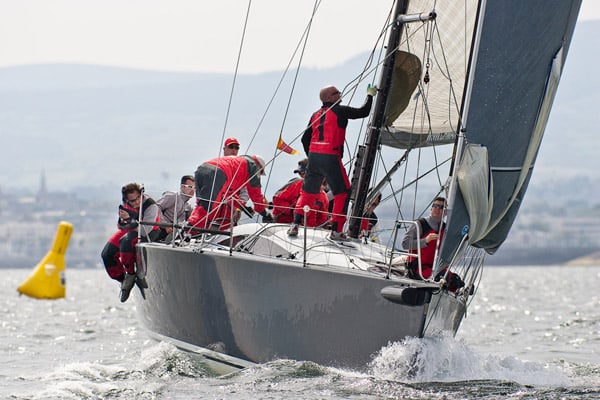
Anthony O'Leary (IRL)
David Lenz (GBR)
Peter O'Leary (IRL)
Ross Deasy (IRL)
Brian Lennon (IRL)
Stephen O'Sullivan (IRL)
Eoin Leahy (IRL)
Frederick Cudmore (IRL)
Simon Johnson (IRL)
Rory O'Sullivan (IRL)
Jimmy Houston (GBR)
Derek Moynan (IRL)
Tom Durcan (IRL)
Robert O'Leary (IRL)
Darragh O'Connor (IRL)
IRL39000 Marinerscove.ie David Dwyer (Mills 39)

Andy Beadsworth (GBR)
David Bolton (IRL)
Padraig Byrne (IRL)
Alan Curran (IRL)
David Dwyer (IRL)
Bernard Fitzpatrick (IRL)
Brian Heneghan (IRL)
David Love (IRL)
Tom Murphy (IRL)
Nicholas O'Leary (IRL)
Clive O'Shea (IRL)
Sandy Rimmington (IRL)
Chris Schirmer (GBR)
Don Wilson (IRL)
IRL36000 Roxy 6 Robert Davies (Corby 36)

Rob Davies (GBR)
Andrew Creighton (IRL)
Marty O'Leary (IRL)
Jim Hughes (IRL)
Paul Farries (GBR)
Nelson Moore (IRL)
Tom Whitburn (GBR)
Michael Liddy (IRL)
Aidan O'Connell (IRL)
Maurice O'Connell (IRL)
Team Management:
Barry Rose, Fintan Cairns, Denis Kiely, Mike Broughton and Norbert Reilly
- RORC
- Anthony O'Leary
- Norbert Reilly
- ICRA
- Eoin Leahy
- Maurice O'Connell
- Commodores Cup
- Fintan Cairns
- Peter O'Leary
- antix
- Mike Broughton
- roxy 6
- Mariners Cove
- David Lenz
- Ross Deasy
- Brian Lennon
- Stephen O'Sullivan
- Frederick Cudmore
- Simon Johnson
- Rory O'Sullivan
- Jimmy Houston
- Derek Moynan
- Tom Durcan
- Robert O'Leary
- Darragh O'Connor
- Andy Beadsworth
- David Bolton
- Padraig Byrne
- Alan Curran
- David Dwyer
- Bernard Fitzpatrick
- Brian Heneghan
- David Love
- Tom Murphy
- Nicholas O'Leary
- Clive O'Shea
- Sandy Rimmington
- Chris Schirmer
- Don Wilson
- Rob Davies
- Andrew Creighton
- Marty O'Leary
- Jim Hughes
- Paul Farries
- Nelson Moore
- Tom Whitburn
- Michael Liddy
- Aidan O'Connell
- Barry Rose
- Denis Kiely




























